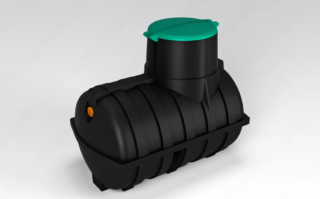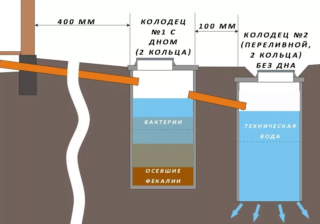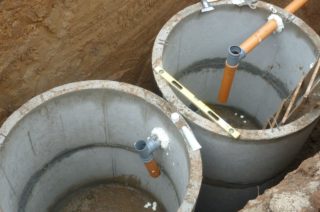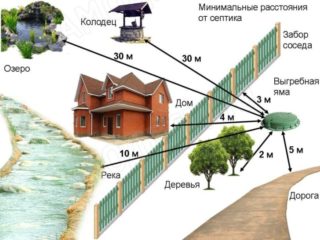Buying a summer house or a country house is a pleasant event, but at the same time problems arise. The first of them is the device of a cesspool for storing household wastewater. There are many varieties, from budget to innovative. For permanent residence, you need to choose a practical, but inexpensive option. The most suitable method according to the criteria is the construction of a septic tank from concrete rings, but there are other solutions.
Types and arrangement of cesspools

For a country house, where people are only in the summer during agricultural work, you can get by with the simplest option from the materials at hand. For example, dig a hole and lay it out with the remnants of brick left after construction. Such a structure will have to be covered with cement from the inside so as not to pollute the soil on which crops grow. The main thing is to choose the right place. Installation of a cesspool must be done away from housing and a well. If the septic tank is intended only for an outdoor toilet, you can buy bacterial preparations that convert fecal matter into fertilizer. For a summer resident, such a tool is just a godsend - no need to buy expensive manure. The method is absolutely safe and fast.
In a private house where it is planned to live permanently, a more universal septic tank is required - you need to correctly make a cesspool so that you do not have to pump it out often.
- Plastic constructions - two or three chambers. Such a system is capable of accumulating solid waste in the first sealed section, pouring excess liquid into the next container for cleaning through filtration fields. For such a choice, it is necessary to comply with the condition - a suitable type of soil. Sandy loam soils and sandstones absorb water well, but loams and clay layers retain it, so you will have to periodically pump out the wastewater. The cost of ready-made autonomous systems is quite high, depending on the number of containers and their volume, as well as the quality of the polymer materials from which they are made.
Concrete ring structure Septic tank made of concrete rings. In terms of cost, such a solution will cost almost half the price, but you will have to spend money on construction equipment that will deliver materials to the site, as well as help install rings in the pit. It is difficult to do it manually, there is a risk of dropping and breaking the concrete. Such a cesspool design will serve for a long time and regularly. It rarely needs to be repaired or serviced. The main thing is that the sewer pipes are laid correctly, otherwise blockages will often form.
If the soil does not allow you to build a septic tank with an open bottom, the best option would be to install a large-volume container in order to order a flusher less often. An important point - it is advisable to choose the volume so that it is a multiple of 4, since the car tank has a volume of 4 cubic meters.
The most expensive option is to build a biological treatment plant. The principle of its action is the processing of organic matter by aerobic microorganisms. This is an innovative technology that allows you to achieve 98% purity of water. For this service, you will have to contact specialized companies that carry out construction work to order. It is expensive, because in addition to the arrangement of the tanks themselves, it is necessary to connect electronic control systems for the process. The most profitable option is to cooperate with the whole village and order a station.It will be dear to one person.
Regulatory Requirements
The following standards should be observed:
- The distance from the residential building is from 5 to 10 meters. This is due to the fact that the septic tank emits a peculiar smell; it is not advisable to place it close to the windows. The ventilation of the cesspool will work constantly - in summer or winter. The second reason is the erosion of the foundation if the septic tank has a leaking structure. Threatens with deformation of the foundation and collapse of the wall.
- The distance to the well is at least 25 meters with loamy soil and more than 50 m with sandy soil. The liquid in the well is groundwater, which can get bacteria and toxins from the septic tank. With a sealed design, this distance is irrelevant. The same applies to an artesian well, which replenishes its reserves from lower soil horizons.
- The septic tank is allowed to be located only on your site and at a distance of 1 meter from a neighbor's fence, as well as at an acceptable distance from their sources of drinking water.
In some regions there are laws according to which it is necessary to obtain a permit for the construction of a certain type of septic tank. In this case, it is better to use the services of a company that is licensed and can provide a guarantee for its work.
Designing and carrying out the necessary calculations
In order for the sewage system in a private house to function continuously and need less repair and cleaning, you need to be guided by the following rules:
- The highway, if possible, is made straight from the house to the septic tank. If this is not possible, it is necessary to calculate the turns: they should not be at right angles - these are potential blockages.
- If the amount of precipitation in the region is large, it makes sense to make a separate storm sewer, which will collect only rainwater.
- Access roads are provided so that the sewer truck can reach the bottom of the pit with a hose. Otherwise, you will have to make a spare container and install a fecal pump to pump waste closer to the road.
- The depth of the groundwater is taken into account. The depth of the cesspool should be higher.
The necessary tools and equipment are ordered based on the selected type of septic tank. Digging a hole under the sewer manually with a shovel is longer and harder. The excavator will do this in a couple of hours, and the construction crane will install the heavy rings in an hour.
Installation steps

Stages of construction of a drain pit made of concrete or reinforced concrete rings:
- Calculate the volume based on the number of residents - on average, 1 person spends 150 liters of water, add to this the consumption from the washing machine.
- Carry out a markup on the site, taking into account the norms of SNiP and the convenience of laying sewer pipes.
- Dig a hole of the required diameter with a margin of about 30 cm on the sides to make a hydraulic lock out of clay.
- Fill the bottom with concrete using a reinforced mesh. If the septic tank has an open bottom, pour a layer of gravel about 50 cm. When the concrete hardens, you can continue to work.
- Place the concrete rings on top of each other using a crane. You can build a formwork and pour in a cement mortar - this will give the structure integrity and there will be no problems with sealing. The joints between the rings are covered with a water-repellent solution. Wet clay is applied from the outside, which will protect the soil from poisonous drains.
- Cut a hole for the incoming pipe and seal the joints.
- Pipes are laid and connected to the internal sewerage system.
- They check the system, fill the highway with sand and soil.
When cornering, if there are any, it is necessary to make inspection wells for the maintenance of the sewage system.
Cost of work
The fastest option for building a septic tank is to entrust the work to specialized firms, where the total cost includes the design of the sewerage system, the price of digging cesspools, the delivery of own materials and craftsmen to the site, and the cleaning of the area after installation. Typically, such companies provide a guarantee for several years of service and conduct routine inspections and maintenance of septic tanks. The cost of work is determined depending on the region and the design of the sewer system.










